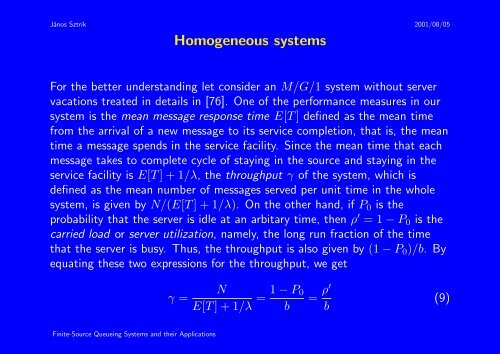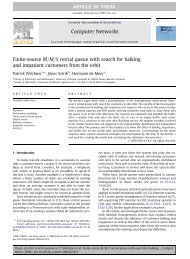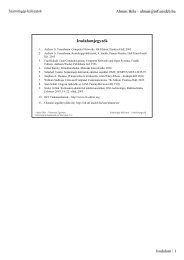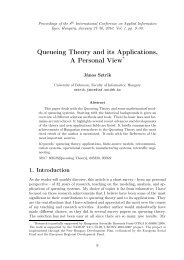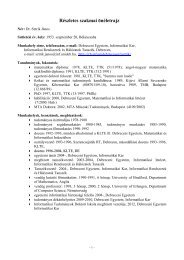Finite-Source Queueing Systems and their Applications
Finite-Source Queueing Systems and their Applications
Finite-Source Queueing Systems and their Applications
Create successful ePaper yourself
Turn your PDF publications into a flip-book with our unique Google optimized e-Paper software.
János Sztrik 2001/08/05<br />
Homogeneous systems<br />
For the better underst<strong>and</strong>ing let consider an M/G/1 system without server<br />
vacations treated in details in [76]. One of the performance measures in our<br />
system is the mean message response time E[T ] defined as the mean time<br />
from the arrival of a new message to its service completion, that is, the mean<br />
time a message spends in the service facility. Since the mean time that each<br />
message takes to complete cycle of staying in the source <strong>and</strong> staying in the<br />
service facility is E[T ] + 1/λ, the throughput γ of the system, which is<br />
defined as the mean number of messages served per unit time in the whole<br />
system, is given by N/(E[T ] + 1/λ). On the other h<strong>and</strong>, if P0 is the<br />
probability that the server is idle at an arbitary time, then ρ ′ = 1 − P0 is the<br />
carried load or server utilization, namely, the long run fraction of the time<br />
that the server is busy. Thus, the throughput is also given by (1 − P0)/b. By<br />
equating these two expressions for the throughput, we get<br />
γ =<br />
<strong>Finite</strong>-<strong>Source</strong> <strong>Queueing</strong> <strong>Systems</strong> <strong>and</strong> <strong>their</strong> <strong>Applications</strong><br />
N<br />
E[T ] + 1/λ<br />
= 1 − P0<br />
b<br />
ρ′<br />
=<br />
b<br />
(9)


